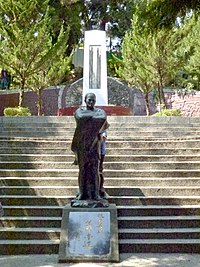Seediq people
Seediq | |
|---|---|
 A statue of Mona Rudao at the Wushe Incident Memorial Park | |
| Total population | |
| 10,485 (April 2020)[1] | |
| Regions with significant populations | |
| Hualien and Nantou county (Taiwan) | |
| Languages | |
| Seediq, Mandarin Chinese | |
| Religion | |
| Animism, Christianity | |
| Related ethnic groups | |
| Atayal, Truku, Kavalan, Taiwanese Aborigines |
The Seediq (sometimes Sediq, Seejiq, pronounced: [seˈʔediq], [səˈdiq], [səˈʔəɟiq]; Chinese:
They were officially recognized as Taiwan's 14th indigenous group on 23 April 2008. Previously, the Seediq, along with the closely related Truku people, were classified as Atayal.[2]
Resistance to colonization
[edit]Wushe events
[edit]Starting from 1897, the Japanese began a road building program that brought them into the indigenous people's territory. This was seen as invasive. Contacts and conflicts escalated and some indigenous people were killed. In 1901, in a battle with the Japanese, indigenous people defeated 670 Japanese soldiers. As a result of this, in 1902, the Japanese isolated Wushe.
Between 1914 and 1917, Japanese forces carried out an aggressive 'pacification' program killing many resisting people. At this time, the leader of Mahebo, Mona Rudao, tried to resist rule by Japan, but he failed twice because his plans were divulged. At his third attempt, he organized seven out of twelve groups to fight against the Japanese forces.
Xincheng events
[edit]When Japanese soldiers raped indigenous women, two leaders and twenty men killed thirteen Japanese soldiers.[3][4][5][6][7][8][9][10]
Renzhiguan events, 1902
[edit]After taking over the plain, Japanese gained control of Wushe. Some of the Tgdaya people who resisted the Japanese were shot. Because of this, fighting broke out again,[11][12][13] leading to the Wushe incident.
Zimeiyuan incident, 1903
[edit]In 1903 the Japanese launched a punitive expedition to seek revenge for their earlier loss at Renzhiguan.[14][15][16][17][18]
Truku War, 1914
[edit]The Japanese wanted to subjugate the Truku group. After eight years of investigating the area, they invaded in 1914. Two thousand of the indigenous people took part in resisting the invasion.[19][20][21][22][23][24][25][26][27] The Japanese deployed 200 machine guns and 10,000 soldiers against the Aboriginals, but grievous wounds were inflicted upon the Japanese Governor-General Sakuma Samata during the war and caused his eventual death.[28][29]
Wushe Incident, 1930
[edit]
The Musha Incident (Chinese and Japanese:
In popular culture
[edit]
The Seediq people featured prominently in the 2011 Taiwanese historical drama film Seediq Bale which depicted the 1930 Wushe Incident along with the earlier Renzhiguan and Zimeiyuan incidents.[30] The Wushe Incident was depicted three times in movies including in 1957 in the film
The albums Seediq Bale (2007) and Takasago Army (2011) by Taiwanese extreme metal band Chthonic talk about the experiences of the Seediq people during the first half of the 20th century presented through fictionalized narratives.[32]
Notable people
[edit]- Iwan Nawi, Deputy Minister of Council of Indigenous Peoples
- Mona Rudao, A major figure during the Wushe Incident and a national hero of Taiwan.
- Walis Perin, Politician, Roman Catholic priest and Minister of the Council of Indigenous Peoples from 2005 to 2007.
- Kung Wen-chi, Taiwanese legislator
- Umin Boya, Taiwanese writer, director, actor
See also
[edit]References
[edit]- ^ "
賽 德 克 族 ",行政 院 原住民 族 委員 會 , 2015年 /12月10日 查閱. - ^ Shih, Hsiu-chuan; Loa, Iok-sin (24 April 2008). "Sediq recognized as 14th tribe". Taipei Times. Retrieved 12 June 2016.
- ^
新城 事件 -臺灣 原住民 歷史 語 言文 化 大 辭典 網 路 版 - ^
新城 事件 歷史 現場 變遷 - ^
新城 事件 - ^
新城 天主堂 -花 蓮 觀光 資 訊網>太 魯閣地區 >熱 門 景 點 - ^
花 蓮 縣 文化 局 >文化 資產 - ^
文化 視野 :太 魯閣事件 的 開 端 :新城 事件 -台灣 立 報 - ^
太 魯閣族 抗日 戰役 史 -和平 國 小 台灣 母語 日 暨原住民 資源 網 - ^ 104
年 台灣 原住民 族 史 (含概要 、大意 )-看 這本就夠了 - ^
國立 自然 科學 博物館 ->賽 德 克 -巴 萊特展 ->事件 ->人 止 關 - ^
人 止 關 事件 -臺灣 原住民 歷史 語 言文 化 大 辭典 網 路 版 - ^
寫真 霧 社 事件 台灣 多樣 性 知識 網 焦點 特 展 - ^
國立 自然 科學 博物館 ->賽 德 克 -巴 萊特展 ->事件 -> 姊妹原 事件 - ^
姐 妹 原 事件 -臺灣 原住民 歷史 語 言文 化 大 辭典 網 路 版 - ^
眉 溪 部落 姜 仁和 耆老-姊妹原 事件 -數 位 典 藏 與 學習 聯合 目錄 - ^ 姊妹
原 事件 - VCenter - 您的影 音 中心 -數 位 典 藏 國家 型 計畫 - ^
真相 .巴 萊: 《賽 德 克 ・巴 萊》的 歷史 真相 與 隨 拍 札 記 (Seediq Bale 5) - ^
臺灣 原住民 族 文化 知識 網 歷史 事件 - ^
太 魯閣戰爭 百 年 回顧 - ^
被 遺忘 的 戰役 _太 魯閣戰役 .mpg - YouTube - ^
太 魯閣戰役 (電 影 粉 絲 團 ) - 【影 片 】百 年 血淚 !被 ... - ^
太 魯閣事件 -臺灣 原住民 歷史 語 言文 化 大 辭典 網 路 版 - ^
太 魯閣戰爭 -臺灣 原住民 歷史 語 言文 化 大 辭典 網 路 版 - ^
太 魯閣 -臺灣 原住民 數 位 博物館 Archived 2015-04-02 at the Wayback Machine - ^ 2014
年 「太 魯閣族 抗日 戰爭 紀 念 系列 活動 」官 方 網 站-本 站消息 - ^ 2014
年 「太 魯閣族 抗日 戰爭 紀 念 系列 活動 」官 方 網 站- Dxgal o ... - ^ Tsai 2005, p. 12.
- ^ Tsai 2009, p. 134.
- ^ darryl (January 4, 2012). "Subjective, objective and indigenous history: Seediq Bale's take on the Wushe Incident". Savage Minds.
- ^ Lee 2012, p. 395.
- ^ https://www.facebook.com/note.php?note_id=10150202621017190 [user-generated source]
External links
[edit]- Sediq recognized as 14th group - Taipei Times, 24 April 2008
- RTI.org
